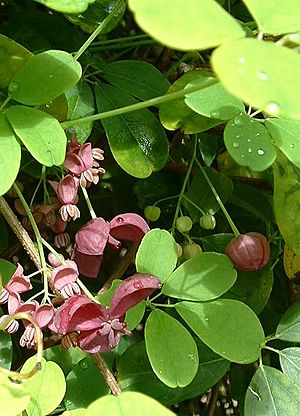Chocolate vine facts for kids
Quick facts for kids Chocolate vine |
|
|---|---|
 |
|
| Scientific classification | |
| Genus: |
Akebia
|
| Species: |
quinata
|
| Synonyms | |
|
Rajania quinata Houtt. |
|
The Akebia quinata, often called chocolate vine, is a cool plant that grows as a shrub. It's originally from Japan, China, and Korea. However, it has spread and become an invasive plant in parts of the eastern United States, from Georgia all the way up to Michigan and Massachusetts.
Contents
What Does the Chocolate Vine Look Like?
The chocolate vine can grow very tall, reaching over 10 meters (about 33 feet) high! It has special leaves made up of five smaller leaflets, which is why it's sometimes called the "five-leaf chocolate vine."
Its flowers grow in bunches and smell like chocolate, which is pretty unique! These flowers have three or four sepals, which are like small leaves that protect the flower bud. After the flowers, the plant grows interesting sausage-shaped fruits. Inside these fruits, there's a sweet, jelly-like pulp with seeds. This pulp is actually edible!
Different Names for the Akebia Quinata
In China, people call Akebia quinata by a few names. One common name is mù tōng, which means "woody thoroughgoing plant." Sometimes, it's also called tōng cǎo, meaning "thoroughgoing grass." These names describe how the plant grows and spreads.
How People Use the Chocolate Vine
The fruit of the chocolate vine has a soft, sweet pulp. It tastes a bit like a white dragonfruit. In Japan, people enjoy this fruit as a special treat when it's in season.
The skin of the fruit can be a little bitter. But it's also used as a vegetable! For example, people might stuff it with ground meat and then deep-fry it. The long, flexible vines of the plant are also useful. They have been traditionally used for weaving baskets.
The stem of the plant contains natural salts, which can help the body get rid of extra water. This is why it has been used in some traditional medicines.
Growing the Akebia Quinata
If you want to grow a chocolate vine, it likes sandy soil that drains water well. It also needs regular watering. However, it's quite tough and can handle dry spells once it's grown.
It's important to know that in some places, the chocolate vine can grow too much and take over other plants. Because of this, it's considered an invasive species in certain areas. This means it's best to avoid planting it there.
Where Did the Name Come From?
The name 'Akebia' comes from the Japanese word 'akebi', which is the local name for this plant.
The second part of its scientific name, 'quinata', means "divided into five." This name likely refers to its leaves, which are divided into five distinct leaflets.
Fun Facts
The Milkfruit shown in the animated series "The Dragon Prince" was inspired by this very vine!
Gallery
See also
 In Spanish: Akebia quinata para niños
In Spanish: Akebia quinata para niños





